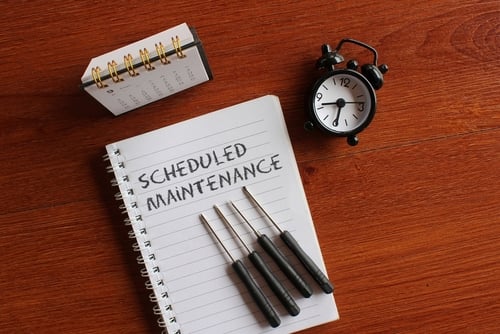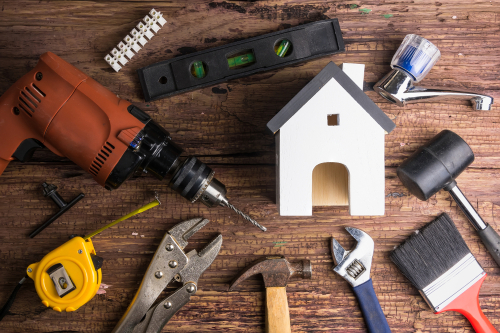Owning rental properties comes with a lot of responsibility. One of the primary responsibilities of running a rental business is scheduling and performing maintenance tasks. Rental maintenance is crucial for several reasons, like preserving the property and retaining tenants. That said, it’s important to create a maintenance schedule to stay on top of potential issues and keep each property in good health. In today’s article, we’ll discuss the importance of routine maintenance and how to create a maintenance schedule that works for your rental business.

Contents of This Article:
- Why Is Rental Maintenance So Important?
- How to Create a Maintenance Schedule
- Hiring Property Management for Maintenance
Why Is Rental Maintenance So Important?
If you’re a rental owner or property manager in Baltimore, you know how crucial rental maintenance is. Without routine maintenance, rental properties are at risk. For instance, you’ll likely run into extensive repairs and issues throughout the property. Additionally, no tenant wants to live in a property that’s not well-maintained and cared for.
As such, it’s vital to stay on top of maintenance tasks and ensure your tenants are on the same page. Here are some of the main reasons why rental maintenance is so important.

- Protects the Property– Regular maintenance helps protect rentals from wear and term, damage, and deterioration. This helps extend the life of a property and maintain its value.
- Ensures Tenant Safety– Rental property maintenance helps to ensure that the rental is safe and secure for tenants and visitors. For instance, it’s important to regularly check smoke detectors, repair faulty wiring, and fix leaks quickly.
- Attracts and Retains Tenants– A well-maintained rental helps attract potential tenants and retain current tenants. After all, tenants are more inclined to renew their lease in a safe and well-cared-for property.
- Reduces Overall Costs– Regular maintenance can help identify issues before they become significant. As a result, this helps to reduce repair costs and prevent costly emergency repairs.
- Legal Compliance– Landlords have legal obligations to keep rental properties in safe and habitable conditions. Failure to perform regular maintenance can result in legal and financial penalties.
How to Create a Maintenance Schedule
If you want to keep your rental property in good condition, it’s important to create a maintenance schedule. Good property management involves scheduling maintenance, hiring contractors, and checking in to ensure properties are in good health. Here’s a guide to creating a maintenance schedule that works for your rental business.

- List Each Task
- Determine the Frequency
- Create a Schedule
- Assign Responsibility
- Review and Update
List Each Task
The first step in creating a rental maintenance schedule is listing the necessary tasks for each property. Depending on the type of properties you own, tasks may differ. Each property needs routine maintenance, like checking smoke detectors, changing air filters, and inspecting for damage. However, there are several more maintenance tasks to plan for throughout the rental process.
For instance, you’ll need to plan for seasonal maintenance. Typical seasonal maintenance tasks include inspecting pipes, looking for water damage, inspecting the roof, cleaning gutters, snow removal, and more. Additionally, exterior maintenance is another crucial aspect of owning rentals. You’ll want to regularly ensure exterior surfaces are in good condition and safe for tenant use.
Finally, you’ll want to perform property turnover maintenance to attract and retain new tenants. This includes completing necessary repairs, replacing or deep cleaning carpets, painting walls, servicing major systems, and more.
Determine the Frequency
Once you’ve determined all the necessary tasks to keep your properties in good health, you can determine how often you need to perform maintenance. Sometimes, unpredictable emergencies pop up that require immediate attention. However, it’s essential to plan for routine maintenance, whether it’s every few months, once a year, or seasonally. Sometimes, it’ll depend on the task type or the property’s age and condition.
Create a Schedule
After determining the frequency of each maintenance task, you can create a maintenance schedule. You’ll want to ensure the schedule outlines when each task should be performed.

Using a calendar or scheduling software to organize and schedule each maintenance task is best to stay on track. Choose a comprehensive tool that works best for you and your team to ensure everybody’s on the same page. There are several great property management tools, such as TenantCloud, Propertyware, Avail, and more.
For each task on your maintenance schedule, include specific details of what needs to be done, including the name and location of the job and any relevant notes or comments. Additionally, include the date and time of when it should be performed to help ensure tasks are completed in a timely manner.
Assign Responsibility
It’s important to specify who’s responsible for each scheduled maintenance task. This helps ensure that tasks are completed on time, and everyone knows their responsibilities. So first, you’ll want to consider who’s best suited to perform each task. For instance, you can hire property managers and contractors and give more minor responsibilities to tenants.
Most rental owners hire comprehensive property management companies to schedule and perform maintenance tasks. However, you may need a professional contractor if the job requires repairing or replacing appliances. Additionally, tenants are responsible for keeping up with housing and occupancy codes, maintaining a sanitary environment, performing some seasonal maintenance, and reporting issues that need repair.
It’s important to include tenant responsibilities in the lease agreement to ensure they know how to keep the property in good health. Additionally, you’ll want to be on the same page as your property managers regarding who’s responsible for each task. That way, you can follow up to ensure they’re getting done. Finally, set up a system for tracking completed tasks or provide incentives for completing tasks on schedule.
Review and Update
Regularly reviewing and updating the maintenance schedule ensures that your property is well-maintained and repairs are minimized. As such, you’ll want to set aside time to review the maintenance schedule, whether once a month or once a quarter, depending on the frequency of maintenance tasks. While reviewing the schedule, you’ll want to evaluate the effectiveness of each task. For example, are there any that need to be added, removed, or performed more frequently?

Once you’ve evaluated your schedule, make any necessary changes and communicate them to everyone involved. Everyone must be on the same page, whether you send out an email, post the schedule in a common area, or hold a meeting. Then, you can get feedback from property managers, contractors, and tenants on the effectiveness of the maintenance schedule.
By reviewing and updating the maintenance schedule, you can ensure your property stays in excellent condition. However, everyone involved must be informed of changes, so communication is key for maximum effectiveness.
Hiring Property Management for Maintenance
Once you create a maintenance schedule for your rental properties, staying on top of it is essential. However, keeping track of maintenance for each can be challenging if you own several rentals. Many busy rental owners hire comprehensive property management to care for their properties. A full-service property management company will ensure your tenants and properties are cared for 24/7.
If you’re looking for a professional and reliable team to care for your rentals, look no further than BMG. Bay Property Management Group offers comprehensive rental management services for properties in and around Baltimore, Philadelphia, Northern Virginia, and Washington, DC. So, contact us today to learn more about our services and how we can help your rental business succeed.
